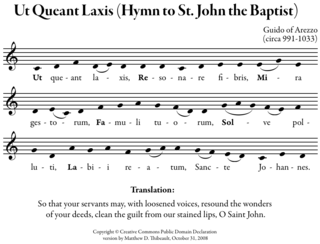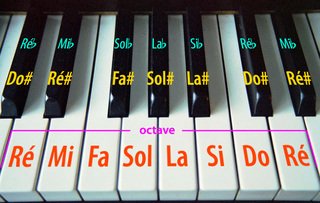How Solfège has Been Taught Differently Than Originally Intended
Everyone reading this probably knows Solfège, though they might not be aware. Do, Re, Mi, Fa, Sol, La, Ti, Do. This is popular because of childhood music classes, and movies like the sound of music.
Solfège is used for sight singing, to make melodies that don't already have words easier to sing on the spot. However, what we have been taught has evolved from the original. Originally it was
Ut - Ut queant laxīs -------------------------------------------------------------- C
Re- resonāre fībrīs --------------------------------------------------------------- D
Mi- Mīra gestōrum ---------------------------------------------------------------- E
Fa- famulī tuōrum ----------------------------------------------------------------- F
Sol- Solve pollūtī ------------------------------------------------------------------ G
La- labiī reātum -------------------------------------------------------------------- A
Si- Sancte Iōhannēs --------------------------------------------------------------- B
These syllables were derived from the lyrics to an old hymn called Ut Queant Laxis. All of the original solfège syllables are in this hymn except for Si which was added later.
[Image Source: en.wikipedia.org Labeled Public Domain]
As you can tell C and B are both different syllables than we are used to (I use fixed do by the way so Do to me is always C and Si is always B). Both were most likely changed to make singing each syllable easier. Ut is a weird syllable to sing, and it would be sung frequently for those who use moveable Do, as it is always scale degree 1. As for Si, I think it was changed as a result of its beginning with the same letter as Sol, so it would be awkward to sing them next to each other, and seeing that they are a major third apart, they will often be paired together.
[Image Source: fr.wikipedia.org Labeled Public Domain]
I do not use Ut in place of Do, but I do use Si in place of Ti. My piano teacher likes Si, and as I have learned, I do too. It is not that awkward to sing Sol and Si near each other, and musicians in many other countries still use Si. I also do not us the Do di Mi me, system, as usually if there is a sharp or flat you usually just sing it the same as the natural, or if you're very picky you sing Do-diesis or Mi-bemolle for C-Sharp and E-Flat. That's how most countries do it, and I think it is important to have a standardized Solfège.
This article is in no way me trying to say, we all need to switch to Fixed Solfège, and use it the exact same way our great great grandparents used it. Change can't be evaded, and everything happens for a reason. I am just writing about the original system and its Pros and Cons. As you can tell from reading this, I don't use it completely originally with Ut in place of Do, but I do use Si.
As I stated, I believe it is important for musicians across the world to be able to communicate without speaking the same language, and Solfège is the way. Most other countries use Si, and diesis and bemolle. That is why I think it is a good idea to use fixed Solfège, but please, live by your beliefs, use your Solfège.

